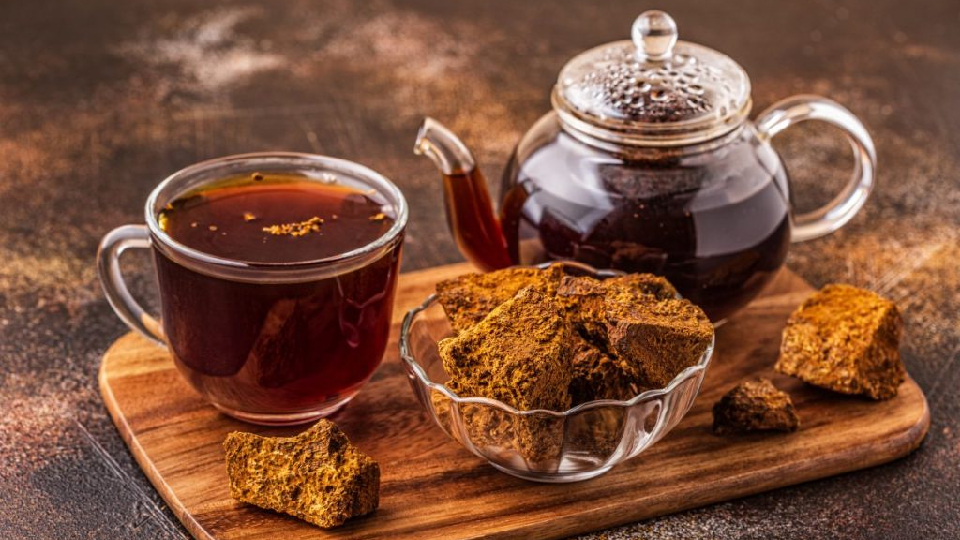How to Make Chaga Tea at Home with Easy Recipes!
Chaga tea, derived from the chaga mushroom, offers potential health benefits and is simple to make. Just steep chaga mushroom chunks in hot water for several hours, resulting in a flavorful tea with earthy notes. It is consumed for its potential immune-boosting and anti-inflammatory properties.
In this article, we’ll provide a step-by-step guide on making chaga tea and explore exciting recipes like chagaccino and chaga iced tea, allowing you to experience the unique advantages of this beverage.
In this article:
What are Chaga Mushrooms?
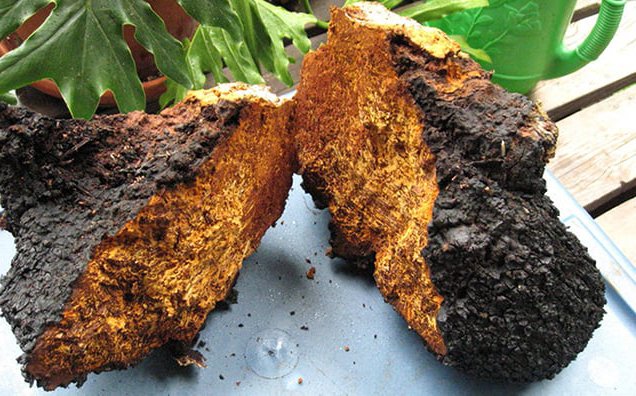
Chaga mushrooms are a type of fungus that grow on birch trees in cold regions like Canada, Alaska, and Siberia. They have a dark appearance and a hard texture. For centuries, people in Europe, Russia, and Siberia have used chaga mushrooms in traditional medicine practices.
The Latin name for chaga mushroom is Inonotus obliquus. Chaga is also known by other names, such as black mass, clinker polypore, birch canker polypore, cinder conk, and the sterile conk trunk rot (of birch).
As you stroll through a forest, you may come across what appears to be a clump of burnt wood or dirt. However, upon closer inspection, you’ll find that it’s actually the chaga mushroom, a fungus with a nutrient-rich, rusty, yellowish-brown interior.
Potential Health Benefits of Chaga
Discover the amazing benefits that Chaga mushrooms have to offer. From boosting immunity to supporting skin health, Chaga provides a wealth of advantages. Learn how incorporating Chaga mushrooms into your routine can enhance your well-being. Embrace the power of nature and unlock the potential of Chaga for a healthier, happier you.
9 Incredible Benefits
1. Boosting the Immune System
Chaga mushrooms have the ability to boost the immune system by containing beta-glucans, which are a type of polysaccharide. Beta-glucans are known to stimulate the production of immune cells that are responsible for fighting viruses, bacteria, and infections. Furthermore, chaga can also regulate the immune system, preventing it from over-reacting and causing inflammation.
2. Liver Protection
Chaga can be considered a valuable supplement for maintaining overall health as it protects the liver. It can help prevent damage caused by toxins and harmful substances, improve liver function, and reduce inflammation[1].
3. Reducing Inflammation
By countering inflammation in the body, Chaga mushrooms’ various compounds, including betulinic acid, ergosterol peroxide, and trametenolic acid, can help reduce the risk of developing chronic diseases like arthritis, heart disease, and cancer[2].
4. Antioxidant Properties
Chaga mushrooms contain various antioxidants such as melanin, polysaccharides, and polyphenols. These antioxidants aid in protecting the body from free radicals, which can cause cell damage. Additionally, they boost the immune system and decrease inflammation.
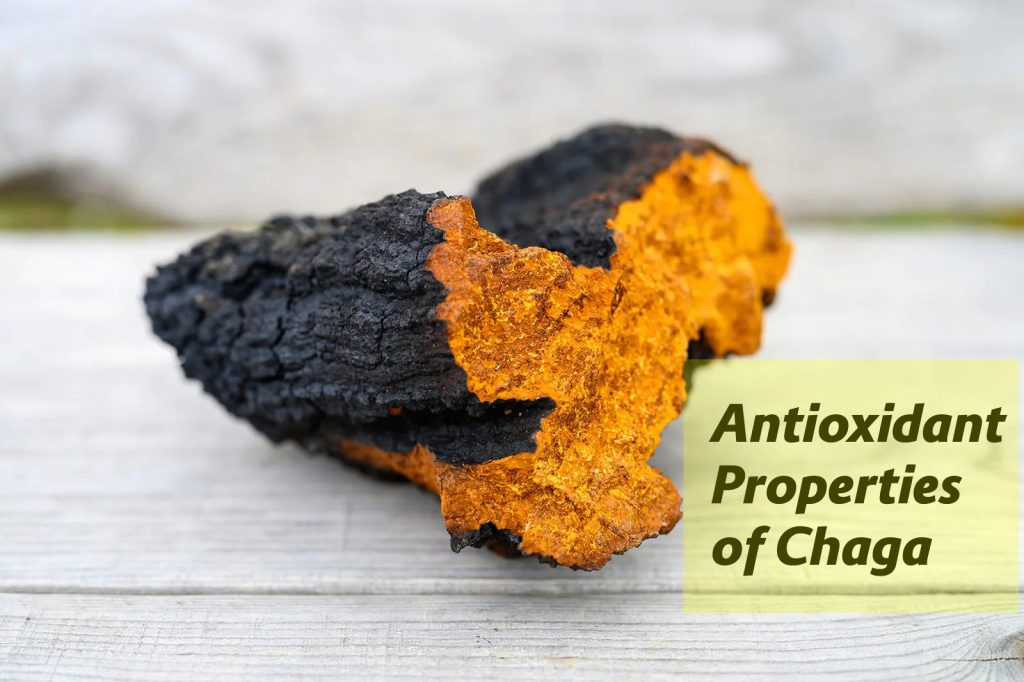
5. Potentially Reducing Cancer Cell Growth
Chaga contains active compounds, including betulinic acid, ergosterol peroxide, and inotodiol, which have been found to slow down the growth of cancer cells. Some studies even indicate that chaga could be a promising treatment for certain types of cancer.[3].
6. Improving Physical Endurance
Research showed that chaga can improve physical endurance and reduce fatigue. This is due to its ability to increase oxygen uptake in the body and improve the body’s ability to use oxygen during exercise – making it a great supplement for athletes.
8. Regulating Blood Sugar Levels
Chaga mushrooms offer an anti-diabetic effect by regulating blood sugar levels in the body. This is achieved by reducing inflammation and improving insulin sensitivity. Individuals with type 2 diabetes may find chaga beneficial in managing their condition.[4].
9. Lowering Cholesterol Levels.
A study showed that chaga mushrooms can help lower cholesterol levels in the body. These include ergosterol peroxide and inotodiol, which can reduce LDL cholesterol and increase HDL cholesterol – reducing the risk of heart disease and stroke.
SUMMURY
While more research is needed to fully understand its effects, chaga is a promising natural remedy that could offer a wide range of health benefits.
Side Effects of Chaga Tea
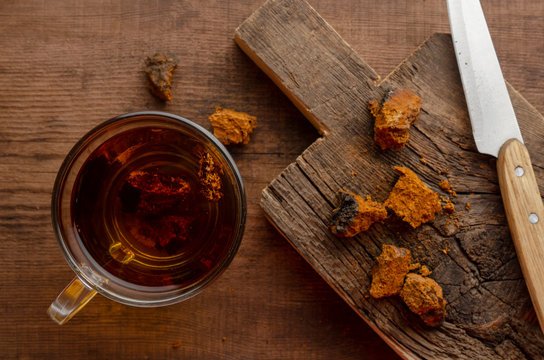
Although Chaga is generally safe for most people, certain individuals may experience side effects. These side effects include allergic reactions, which may result in symptoms such as skin rash, itching, or difficulty breathing. If you encounter any of these symptoms, discontinue the use of chaga and seek medical attention if necessary.
Moreover, digestive issues such as diarrhea, constipation, or stomach upset may occur in some people after ingesting chaga. Individuals with diabetes should also monitor their blood sugar levels carefully, as chaga can affect them.
IMPORTANT NOTE
If you are taking blood-thinning medication, it is vital to consult with your healthcare provider before consuming chaga, as it may interact with the medication. If you have pre-existing medical conditions or are taking medication, it’s always best to talk to your healthcare provider before using chaga.
How to Prepare Chaga Tea
To prepare chaga for tea, you can grind it into a fine powder or use dried chaga chunks. When using chunks, breaking them into smaller pieces can make them easier to brew.
Chaga Mushrooms Preparation
1. Water Temperature
Heat water to an ideal temperature range of 140-160°F (60-71°C). Be careful not to let the water boil since it could harm the beneficial compounds in the chaga.
2. Water to Chaga Ratio:
Use one tablespoon of chaga per eight ounces of water. Adjust the amount of chaga as per your preference to taste and strength.
3. Steeping
Steep your chaga for at least four hours or overnight to get the maximum flavor and health benefits from the mushroom. Once finished, strain the tea and enjoy.
How to Make Chaga Tea
To obtain the maximum benefit from chaga tea, it’s essential to use the correct preparation method. To begin, start by keeping the temperature low and simmering the tea at 140-160°F for at least 15 minutes. This is necessary because the chitin material that shields the nutrients of chaga requires an extended simmering time.
To make a more potent tea, it’s recommended to use high-quality chaga extract powder instead of chaga chunks, as a smaller amount is needed.
By adhering to the proper brewing method, you can unlock the advantageous bioactive compounds of chaga. Its long history of consumption as a tea in countries such as Finland and Russia makes it a beverage with a rich tradition that you can trust.
There are two different methods to brew this tea:
Method 1: Using Chaga Powder
- Boil water and let it cool to 140-160°F (60-71°C).
- Add one tablespoon of chaga powder to eight ounces of water.
- Steep the chaga for at least four hours, or even overnight.
- Strain the tea using a fine-mesh strainer or cheesecloth.
- Enjoy your chaga tea plain or with a sweetener of your choice.
Method 2: Using Chaga Chunks
- Break the dried chaga chunks into smaller pieces.
- Boil water and let it cool to 140-160°F (60-71°C).
- Add the chaga chunks to the water and let them simmer for at least an hour, or even overnight.
- Strain the tea using a fine-mesh strainer or cheesecloth.
- Enjoy your chaga tea plain or with a sweetener of your choice.
Helpful Tips:
- Use high-quality chaga mushrooms for the best flavor and health benefits.
- Add other herbs or spices like cinnamon, ginger, or honey to enhance the flavor.
- Store chaga tea in the refrigerator for up to a week.
- Experiment with the water to chaga ratio and steeping time to find your preferred taste and strength.
How to Use Them
Whether you prefer your tea sweetened or unsweetened, there are several ways to enjoy the rich and earthy taste of chaga tea. For a cool and refreshing summer beverage, simply chill the tea and serve it over ice. If you’re in the mood for something warm and cozy, try making a chagaccino, a latte-style drink.
Regardless of how you choose to enjoy it, chaga tea is a delicious and unique experience that offers a range of potential health benefits. So go ahead and try it for yourself and see why this mushroom has been cherished for centuries as a valuable source of nourishment and wellness.
Chaga Tea Recipes
Try out our two delicious recipes: Chagaccino and Chaga Iced Tea.
A Recipe for a Delicious Chagaccino
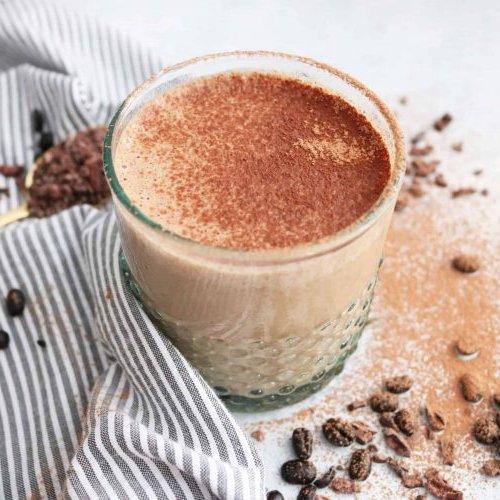
Ingredients
Instructions
- Brew a cup of chaga tea using your preferred method (such as using chaga powder or chaga chunks).
- In a saucepan, heat up the milk, honey, vanilla extract, and cinnamon over medium heat.
- Once the milk mixture is heated and frothy, pour it into a blender.
- Add the brewed chaga tea to the blender and blend until well combined.
- Pour the Chagaccino into a mug and top with whipped cream (if desired).
- Enjoy your delicious and healthy Chagaccino!
Refreshing Chaga Iced Tea recipe

Ingredients
Instructions
- Boil the water in a pot and remove from heat.
- Add the chaga powder or dried chaga chunks to the water and let it steep for 4-6 hours.
- Strain the tea using a fine-mesh strainer or cheesecloth and discard the chaga.
- Stir in the honey or maple syrup (if desired) until dissolved.
- Let the tea cool to room temperature, then transfer it to a pitcher and refrigerate until chilled.
- When ready to serve, fill a glass with ice cubes and pour the chilled chaga tea over the ice.
- Garnish with lemon slices or fresh mint leaves (optional).
- Enjoy your refreshing chaga iced tea!
Other Uses for Chaga
1. Chaga Extract Supplements
Chaga extract supplements are a type of dietary supplement that contains concentrated chaga mushroom extract. They are believed to provide the same health benefits as chaga tea, such as supporting the immune system, providing antioxidant properties, and reducing inflammation.
2. Skincare Products
Skincare products utilize chaga because they contain melanin, which is known to protect the skin from harmful UV rays. Lotions, creams, and serums can all incorporate chaga to improve skin health, decrease inflammation, and fight signs of aging.
3. Cooking Ingredients
In addition to making tea, chaga mushrooms can be used in cooking to add a nutty, earthy flavor to dishes. They can be used as a seasoning for meats and vegetables, or as a base for broths and soups.
4. Chaga Coffee
Chaga coffee is a type of coffee that includes chaga as an ingredient. It is believed to have similar health benefits as tea, including immune system support and antioxidant properties.
5. DIY Natural Dyes
Chaga mushrooms can be used to create natural dyes for fabrics and textiles. The melanin in chaga mushrooms can produce a range of colors, including shades of brown, orange, and yellow.
What Does Chaga Tea Taste Like?
Chaga tea has a unique and earthy flavor profile with a hint of sweetness. Some compare its taste to that of coffee or black tea, while others describe it as having a woody or mushroom-like taste.
The taste of this tea can vary depending on the preparation method and the quality of the chaga used. For example, chaga that has been boiled for an extended period may have a more bitter taste than tea made from chaga extract powder.
While the taste of chaga tea may not appeal to everyone, its potential health benefits make it a worthwhile beverage to try. All in all, if you’re unsure about the taste, you can always add honey, milk, or other flavorings to enhance the flavor to your liking.
Where to Buy Chaga Tea
You can purchase chaga mushroom tea from a variety of retailers, including health food stores, specialty tea shops, and online retailers. It’s important to select a high-quality organic chaga tea to ensure that you receive the greatest health benefits. Popular brands of Chaga tea include:
Buddha Teas Organic Chaga Tea
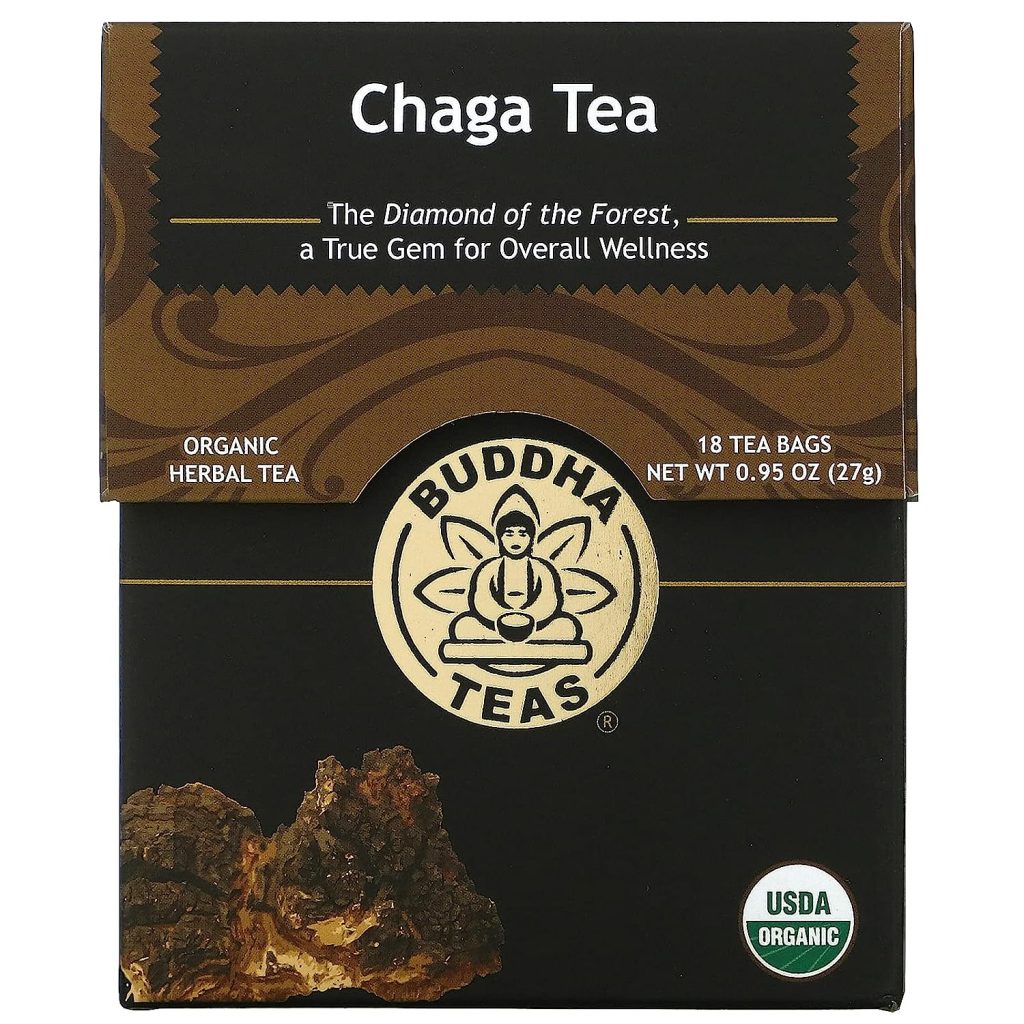
- Wellness Focused
- Premium Ingredients
- Clean and Bleach-Free
- Highest standards of kosher certification
- No Artificial Flavors, Colors, or Preservatives
Sayan Siberian Pure Raw Chaga Mushroom Chunks
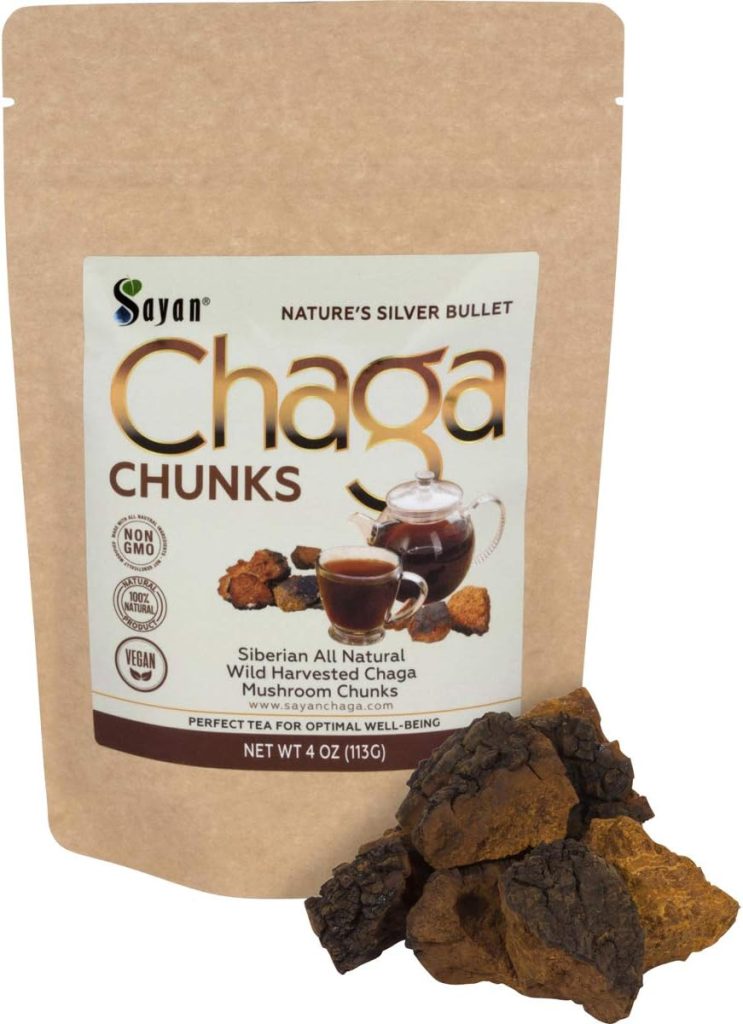
- Wild Forest Harvested
- Supports Immune System
- Improve Digestive Health
- Powerful Antioxidant and Adaptogen
- Convenient and Ready to Use
- Non-GMO and Gluten-Free
Om Mushroom Superfood Chaga Organic Mushroom Powder
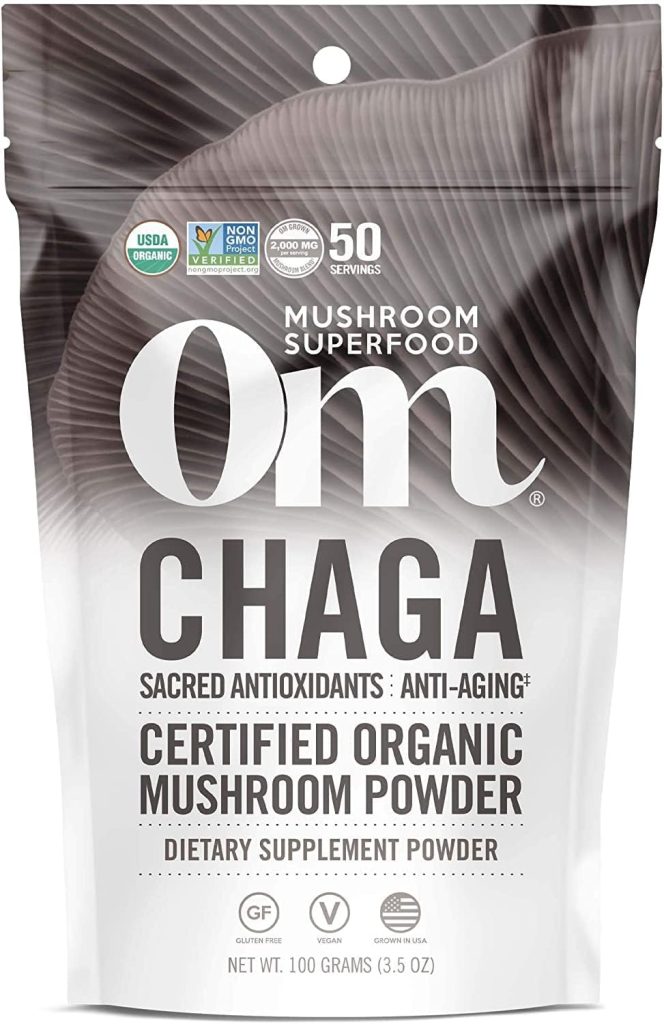
- Certified Organic
- Sacred Antioxidants
- support Immune Support
- Anti-Aging
- Balances Metabolic System
- USA Grown and 3rd-Party Tested
FAQs
Is it OK to Drink Chaga Tea Everyday?
Drinking Chaga tea daily is generally safe for most people. It offers potential health benefits, but moderation is key. Start with a small amount and monitor your body’s response. Consult a healthcare professional if you have concerns or experience any adverse effects.
How to Prepare Chaga for Consumption?
To prepare chaga for consumption, it is recommended to use hot water and steep the chaga chunks or powder for several hours. You can also simmer the chaga on low heat for a longer period to extract more nutrients.
How to Make the Best Chaga Tea?
To make the best Chaga tea, follow these steps:
- Break Chaga into small pieces.
- Simmer in water for at least 30 minutes.
- Strain and serve. Adjust brewing time and Chaga-to-water ratio to taste. Experiment with honey or spices for added flavor. Enjoy this nutritious and earthy tea.
Do You Have to Dry Chaga Before Making Tea?
You don’t have to dry Chaga before making tea, but it’s common practice. Drying it helps preserve Chaga and makes it easier to store and transport. However, you can also use fresh Chaga directly for brewing tea if it’s available and you prefer its flavor and texture.
What is Chaga Tea Good for?
Chaga tea is known for its potential health benefits. It’s rich in antioxidants and may support the immune system, reduce inflammation, and offer anti-cancer properties. Some people use it for overall well-being, but consult a healthcare professional before using it as a substitute for medical treatment.
How Much Chaga Tea Should I Drink a Day?
Typically, you can start with 1-2 cups of Chaga tea per day. However, it’s essential to listen to your body and adjust the amount based on how you feel. Consult a healthcare provider for personalized advice, especially if you have any underlying health conditions or concerns about Chaga tea consumption.
How Does Chaga Make You Feel?
Chaga can make you feel energized and alert due to its potential health benefits. Some people report improved well-being and enhanced vitality when regularly consuming Chaga tea. However, individual responses may vary, so it’s best to try it in moderation and observe how it affects your body.
Conclusion
In conclusion, Chaga tea offers a delightful and healthful way to harness the potential benefits of this remarkable natural ingredient. With its unique properties, Chaga has gained recognition as a potent immune booster and a fighter against inflammation. Incorporating Chaga into your daily routine is easier than you might think. There are various methods to enjoy its goodness, from traditional Chaga tea preparation to innovative recipes like the invigorating Chagaccino or refreshing Chaga iced tea.
Don’t miss out on the chance to elevate your well-being with Chaga. Start exploring the wonders of Chaga tea today and unlock a whole new level of vitality and enjoyment for your body and soul.
References
1. Inonotus obliquus and its bioactive compounds alleviate non-alcoholic fatty liver disease via regulating FXR/SHP/SREBP-1c axis https://www.sciencedirect.com/science/article/abs/pii/S0014299922001029
2. Anti-inflammatory and anticancer activities of extracts and compounds from the mushroom Inonotus obliquus https://www.researchgate.net/publication/236125885_Anti-inflammatory_and_anticancer_activities_of_extracts_and_compounds_from_the_mushroom_Inonotus_obliquus
3. Biological and anticancer properties of Inonotus obliquus extracts https://www.sciencedirect.com/science/article/abs/pii/S1359511318304537
4. Methanol extract of Inonotus obliquus improves type 2 diabetes mellitus through modifying intestinal flora https://www.researchgate.net/publication/366922038_Methanol_extract_of_Inonotus_obliquus_improves_type_2_diabetes_mellitus_through_modifying_intestinal_flora

